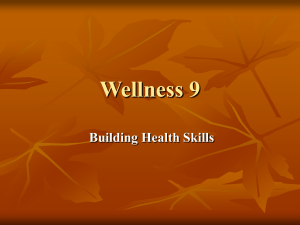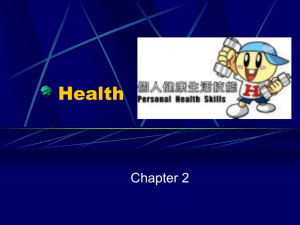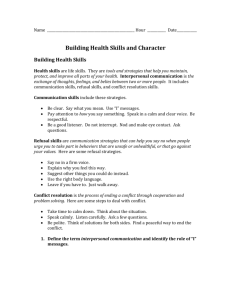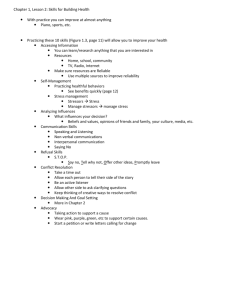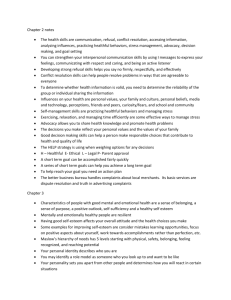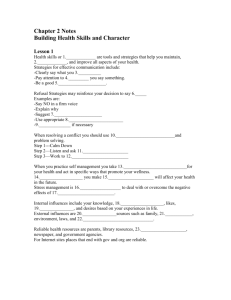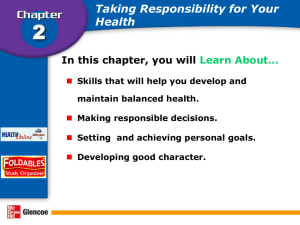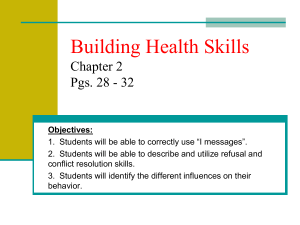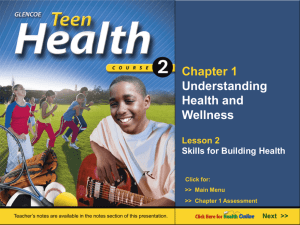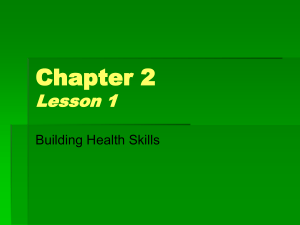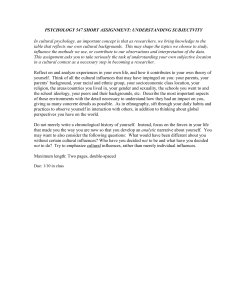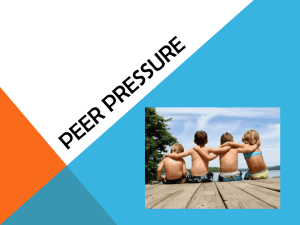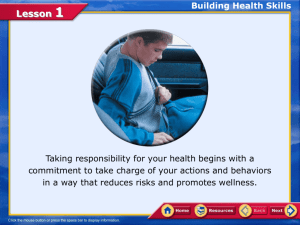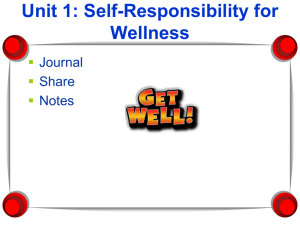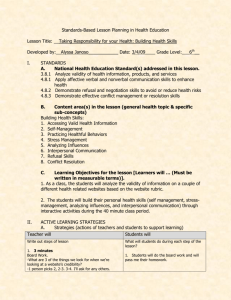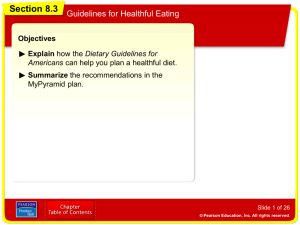Building health skills and character
advertisement
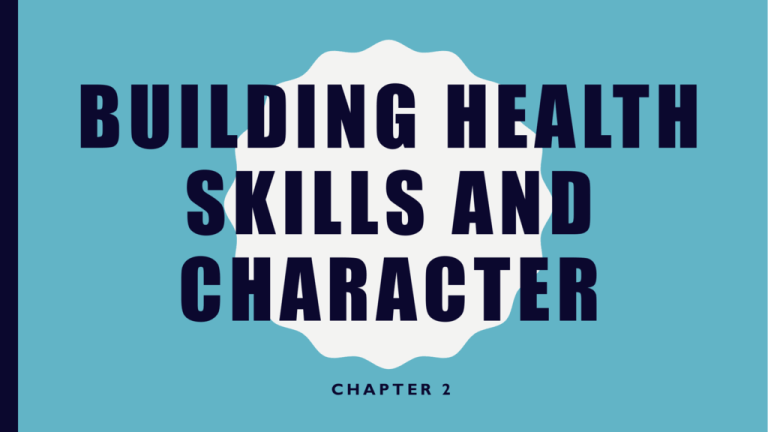
BUILDING HEALTH SKILLS AND CHARACTER CHAPTER 2 LESSON 1 – BUILDING HEALTH SKILLS 1. What is the first step toward taking responsibility for your health? • To develop health skills. 2. Define the term health skills. • Specific tools and strategies that help you maintain, protect, and improve all aspects of your health. 3. Explain what is involved in having effective communication skills. • Making yourself heard/being a good listener. LESSON 1 - CONTINUED 4. List three strategies for effective communication. • Clearly say what you mean. • Pay attention to how you say something. • Be a good listener. 5. Answer the following questions about refusal skills. Define the term refusal skills. • Communication strategies that can help you say no. List five refusal strategies that can help you reinforce your decision to say no. LESSON 1 - CONTINUED • Say no in a firm voice. • Explain why. • Suggest alternatives. • Use appropriate body language. • Leave if necessary. 6. Answer the following questions about conflict resolution. What is conflict resolution. • Process of ending a conflict through cooperation/problem solving. LESSON 1 - CONTINUED What is one attitude that can be considered the key to conflict resolution? • Respecting others rights and your own. List three steps to follow when dealing with a conflict. • Calm down/think it through. • Speak calmly/pay attention/ask questions. • Be polite/brainstorm for solutions. 7. For what do you take responsibility when you practice selfmanagement. • Your health. LESSON 1 - CONTINUED 8. List six practices that promote healthful behaviors. • Eating nutritious foods. • Regular medical/dental checkups. • Avoid alcohol/tobacco/other drugs. • Express feelings in a healthful way. • Build self esteem. • Maintain healthy relationships. 9. Answer the following questions about stress management. LESSON 1 - CONTINUED Define the term stress management. • Ways to deal with or overcome the negative effects of stress. List two strategies that can be used for managing stress. • Physical activity. • Listening to music. 10. In the first column below, list three internal influences that can affect your health choices. In the second column, list three external influences. LESSON 1 - CONTINUED Internal influences • Values/likes/dislikes. External influences • Family/friends/environment. 11. List two sources of health information that can be considered reliable. • Parents/library resources. 12. Define the term advocacy. • Taking action to influence others to address a health related concern or to support a health-related belief. LESSON 2 – MAKING RESPONSIBLE DECISIONS AND SETTING GOALS 1. Define the term decision-making skills. • Steps that enable you to make a healthful decision. 2. What are the decision making steps designed to help you do? • Make decisions that protect your rights/health while respecting the rights/health of others. 3. Why is it helpful to seek advice from those with more experience, such as parent/guardians? • Provide valuable feedback/strengthen family bonds. LESSON 2 - CONTINUED 4. List the six basic steps for making a decision. For each step, include an explanation of what might be involved. (See page 34, Figure 2.3) 5. What are values? • Ideas, beliefs, and attitudes about what is important that help guide the way you live. 6. Define the term goal. • Something you aim for that takes planning and work. LESSON 2 - CONTINUED 7. What are two possible positive results of setting goals? • Focusing your energy on things you want to change. • Build self confidence/increase self-esteem. 8. Define the terms short-term goal and long-term goal. • Short-term goal – goal that you can reach in a short period of time. • Long-term goal – goal that you plan to reach over an extended period of time. LESSON 2 - CONTINUED 9. What is an action plan? • A multistep strategy to identify and achieve your goals. 10. List the six steps to follow when creating an action plan. (See page 36) LESSON 3 – BUILDING CHARACTER 1. Define the term character. • Distinctive qualities that can describe how a person thinks, feels, and behaves. 2. What does it mean to be a person with good character? • You demonstrate responsibility, honesty, integrity, and respect. 3. Explain how your character can impact each side of your health triangle. LESSON 3 - CONTINUED • More likely eat nutritious foods/physically active. • Act with responsibility and fairness will improve both social and mental/emotional health. 4. In the first column below, list the six traits that contribute to good character. In the second column, give two examples of how each trait might be demonstrated. (See page 38, Figure 2.4) 5. When do most people learn character and core ethical values. • When you are young/developed throughout life. LESSON 3 - CONTINUED 6. Describe three ways you can take a more active role in your character development? • Stand up for your beliefs. • Learn from others/ask family members. • Volunteer. 7. What is a role model? • Someone whose success or behavior serves as an example for others. LESSON 3 - CONTINUED 8. Give one example of how someone could demonstrate good character and have a positive effect in each situation listed below. • Home – carrying out your responsibilities. • School – follow rules/respect teacher/students. • Community – obey laws/tolerant of peoples differences.
